Greetings Friends,
Welcome back to The Daily Bandha. I’m just now returning to the blogosphere after completing an intensive year of study in Sports Medicine and will be sharing with you some of the knowledge I gained about the body and how to apply it to your yoga practice and teaching. Our first post in this series looks at a common disorder that can affect the foot.
Welcome back to The Daily Bandha. I’m just now returning to the blogosphere after completing an intensive year of study in Sports Medicine and will be sharing with you some of the knowledge I gained about the body and how to apply it to your yoga practice and teaching. Our first post in this series looks at a common disorder that can affect the foot.
You
can learn a great deal about the normal function of the
musculoskeletal system by looking at what happens when things go
wrong. This knowledge can be used to deepen your practice, prevent
injuries and to understand the role of yoga as a therapeutic adjunct
in the management of various disorders. With this in mind, let’s
focus on the condition known as adult acquired flat foot deformity,
its anatomical basis and how to work with yoga to maintain a
healthy foot arch.
As
I discuss in "The Key Muscles of Yoga" and "The Key Poses of Yoga", mobility and stability
about the joints is a function of three variables; the shape of the
bones, the capsuloligamentous structures that connect the bones to
each other at the joints, and the muscles that surround the joint.
Adult acquired flat foot deformity is a disorder that relates to a
muscular insufficiency of the tibialis posterior muscle, which in
turn leads to weakening of the calcaneo-navicular ligament and then
collapse of the bony arch.
The
underlying muscular imbalance in acquired flatfoot deformity is
between the weakened tibialis posterior muscle on the inside of the
foot and its stronger antagonist, the peroneus brevis muscle on the
outside. This imbalance places undue stress the calcaneo-navicular
ligament that can lead to pain and collapse of the medial foot arch.
The
exact underlying cause of adult-acquired flatfoot deformity is
unknown, but is thought to be multifactorial; however, the muscular
imbalance I describe is well established. In addition, it is
associated with tightness of the Achilles tendon and its
associated muscles, the gastrocnemius and soleus (so stretching these
muscles can be an important factor in management and prevention).
This problem affects women more frequently than men, typically at
around the 6th
decade of life.
Here’s the anatomy:
(Note: if
you’re new to anatomy, focus on studying the images.)
The
calcaneo-navicular ligament runs between the calcaneus, or heel bone
and the navicular bone. The navicular is a boat shaped bone in the
medial mid-foot (hence its name). This ligament is an important stabilizer of the medial longitudinal foot arch.
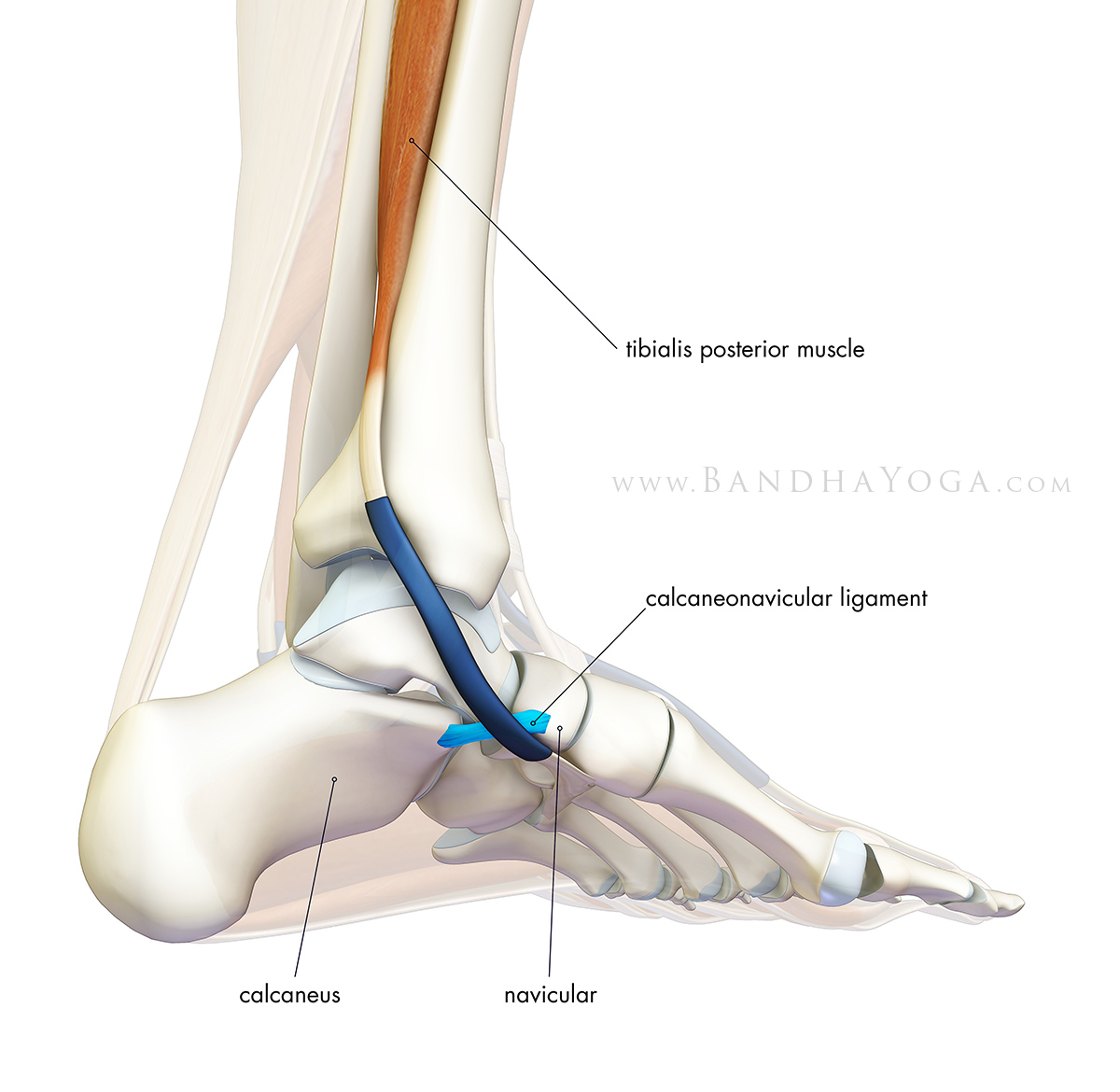 |
| The calcaneo-navicular ligament supports the medial arch of the foot |
The
key muscle providing support for the calcaneo-navicular ligament is
the tibialis posterior. This muscle originates from the interosseous
membrane, the upper 2/3rds of the posterior fibula and the upper
posterior tibia. After passing under the calcaneo-navicular ligament, it splits into two parts: one inserts onto the navicular bone and the
other divides again to insert onto the plantar surfaces of second
through fourth metatarsals and the second cuneiform bones (of the
midfoot).
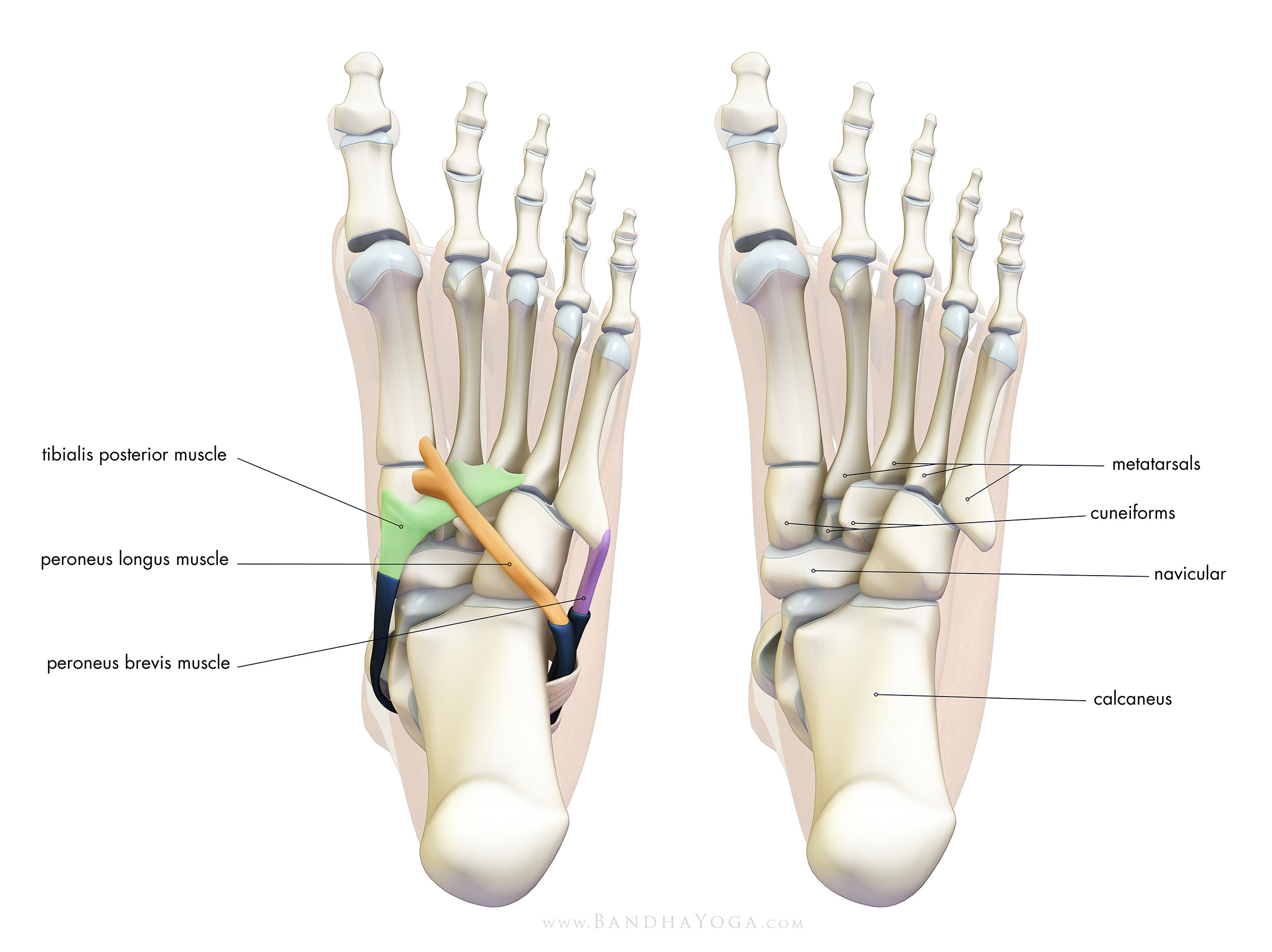 |
| The bones of the foot with muscle insertions |
The
principle action of the tibialis posterior is to invert (supinate)
the foot, with secondary actions of adduction of the foot and flexion
of the ankle. It is an important stabilizer of the midfoot during the
“heel off” phase of walking. The tibialis anterior muscle, which
inserts onto the inside of the midfoot, works with the tibialis
posterior to invert (supinate) the foot.
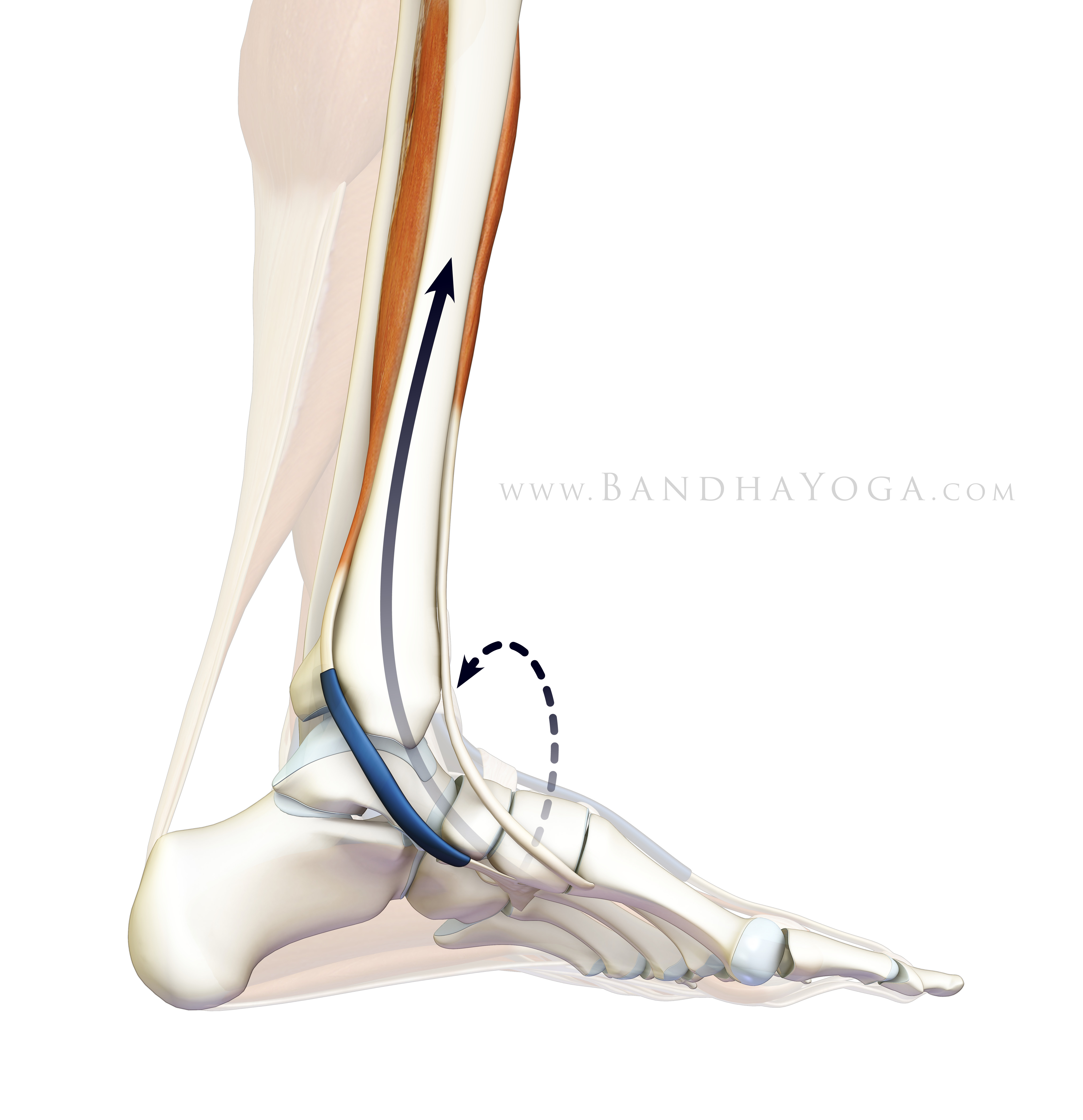 |
| Pressing down the outer edge of the foot engages the tibialis posterior and anterior |
The
antagonist to the tibialis posterior is the peroneus brevis muscle,
which originates from the lower 2/3rds of the lateral (outer) fibula
bone and inserts onto the styloid process at the base of the fifth
metatarsal. It acts to evert (pronate) the foot and plantar flex the
ankle. The peroneus longus works with the peroneus brevis to evert
(pronate) the foot. It also helps to stabilize the transverse arch.
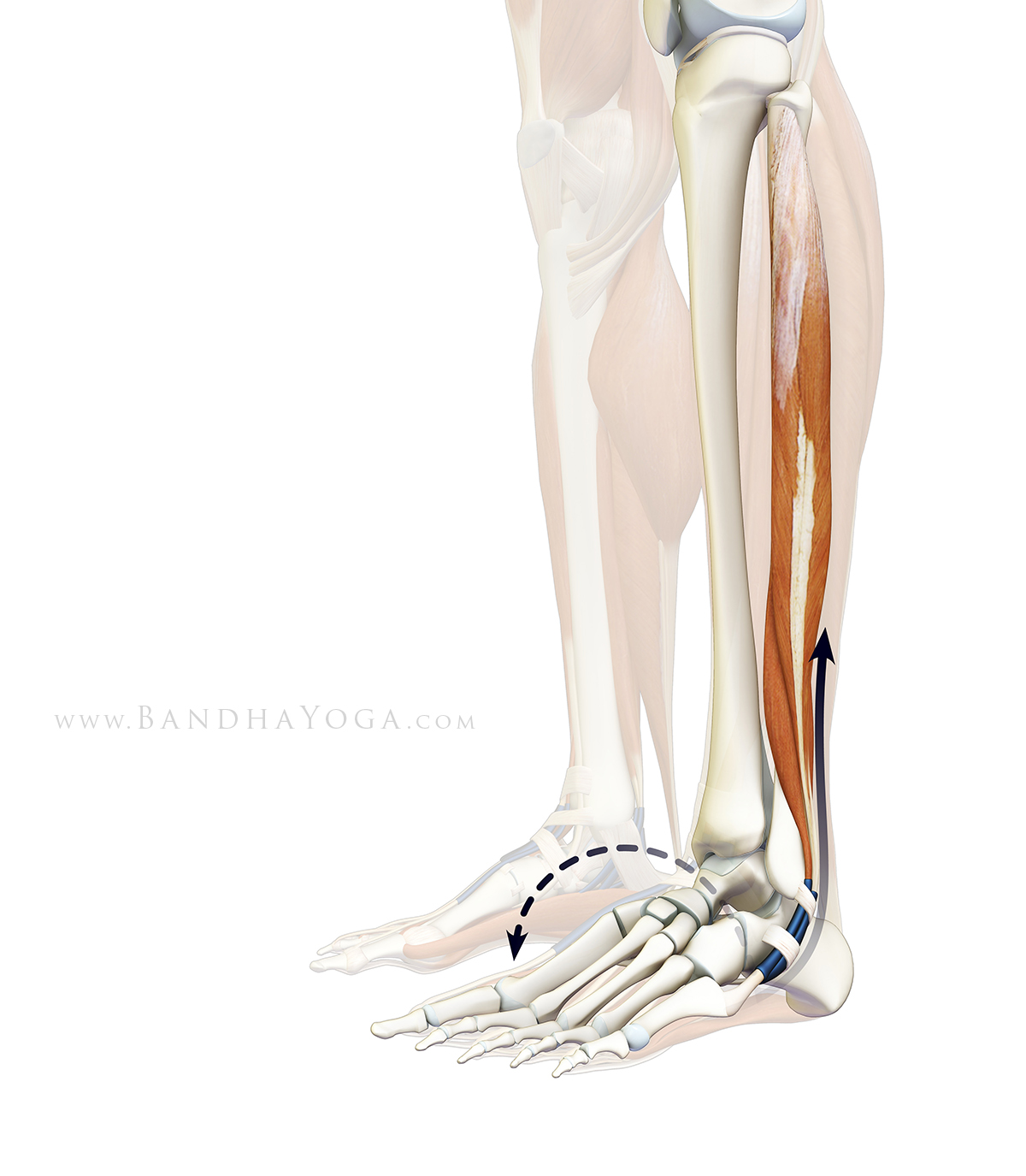 |
| Pressing the ball of the foot engages the peroneus longus and brevis |
Here’s the yoga cue…
In
standing poses like Utthita Trikonasana, press the outer edge of the
foot into the mat to engage the tibialis posterior. Holding this
action, then press the ball of the foot into the mat to engage the
peronei. Note how the medial (inside) foot arch lifts. This sequence
of cues: 1) uses the tibialis posterior to support the medial arch
and; 2) uses the peronei (on the outside of the lower leg) to provide
resistance to strengthen its antagonist, the tibialis posterior.
The biomechanical term for simultaneously engaging antagonist muscles
is “co-contraction” or “co-activation”. We illustrate many
examples of co-activation in the Yoga Mat Companion book series.
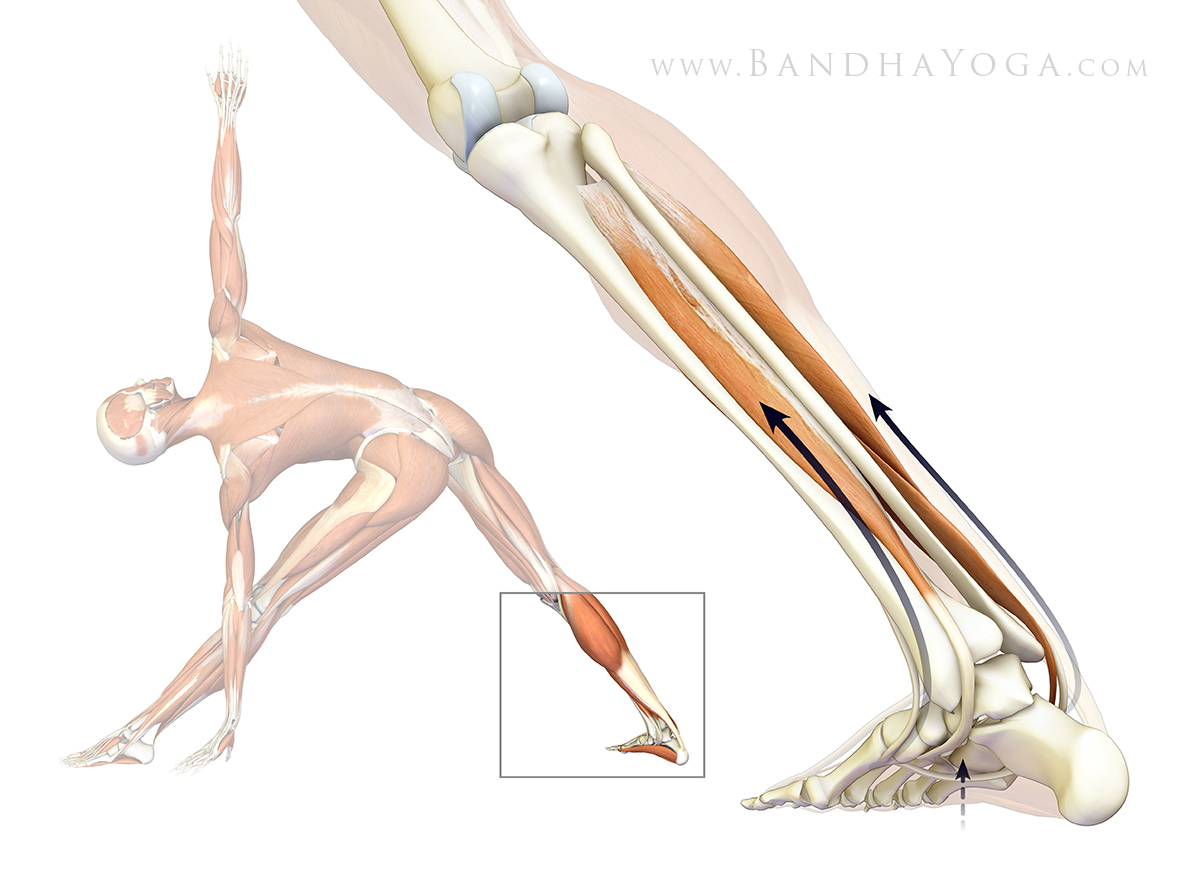 |
| Co-activating the muscles that invert and evert the foot |
Once
you get a feel for this in the back foot, then try the same sequence
in the front foot, and then in other poses such as tadasana. To see
an example of this in downward facing Dog Pose click here. You can
also combine it with engaging the thoracolumbar fascia to lengthen
the trunk in Dog pose. Click here for more information on the
thoracolumbar fascia.
Working
with these types of cues strengthens the arch of the foot. This gives
a feeling of lightness in the step as we go through the day. Remember
that the feet are important centers in energetic anatomy and
physiology and are thought to be the location of minor chakras.
Finally, look at the importance of the feet for the mind-body connection, as illustrated by their representation in the brain on
the homunculus.
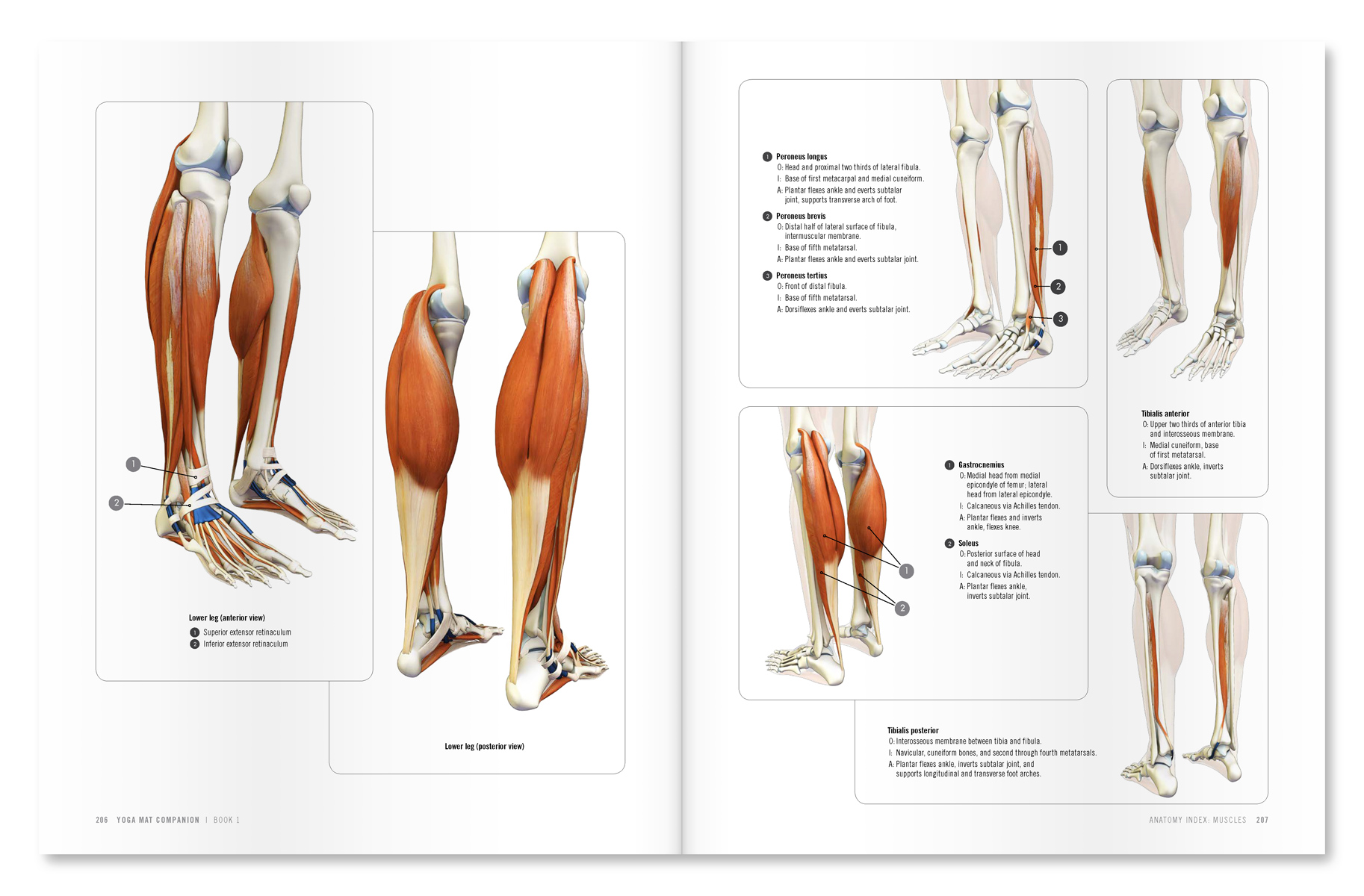 |
| An excerpt from "Yoga Mat Companion 1 - Anatomy for Vinyasa Flow and Standing Poses". |
 |
| An excerpt from "Yoga Mat Companion 1 - Anatomy for Vinyasa Flow and Standing Poses". |
Thanks
for stopping by. Be sure to click here to page through our complete books. Stay tuned for our next post on the foot and yoga.
Also, please be sure to share us on Facebook and Twitter.
All the Best,
Ray Long, MD
Ray Long, MD
References:
1) Alvarez RG, Marini A, Schmitt C, Saltzman CL. “Stage I and II posterior tibial tendon dysfunction treated by a structured nonoperative management protocol: an orthosis and exercise program.” Foot Ankle Int. 2006 Jan (1): 2-8
2) Imhauser CW, Abidi NA, Frankel DZ, Gavin K, Siegler S. “Biomechanical evaluation of the efficacy of external stabilizers in the conservative treatment of acquired flatfoot deformity.” Foot Ankle Int. 2002 Aug; 23 (8): 727-37.
3) Imhauser CW, Siegler S, Abidi NA, Frankel DZ. “The effect of posterior tibialis tendon dysfunction on the plantar pressure characteristics and the kinematics of the arch and the hindfoot.” Clin Biomech. 2004 Feb;19(2):161-9.
4) Lin JL, Balbas J, Richardson EG. “Results of non-surgical treatment of stage II posterior tibial tendon dysfunction: a 7- to 10-year followup.” Foot Ankle Int. 2008 Aug;29(8):781-6

Pls, where can I find more information about the week in paradise at Blue Spirit for our second annual intensive on anatomy, biomechanics and therapeutics for Hatha yoga.?
ReplyDeleteI live in Portugal
fatima b
Hi Fatima,
DeleteThanks for letting me know we forgot the link ;)
If you click on the link above where we mention Blue Spirit, that will take you to the info/registration site for the workshop.
Hope to see you there!
Ray
Glad to see this again. I have been wondering what happened to this 'gift.
ReplyDeleteThank you
Thanks Anon! Ray
DeleteAs a yoga teacher who works primarily with professional athletes, proper foot function is critical to an effective kinematic sequence. This is great information and I look forward to learning more.
ReplyDeleteNamaste,
Katherine Roberts
Good to see your comment, Katherine--delighted that you enjoy the blog~Ray
DeleteI MISSED YOU!!!
ReplyDeleteMissed you guys too! Ray
DeleteI have flat feet, and I consciously pull up the arches and go onto the ball & edge of the foot in yoga. Nice to have what I do confirmed by an expert!
ReplyDeleteThank you!
He he, Thanks for validating it from your practice perspective, Cathy! Ray
Deletegreat to see that you are back!
ReplyDeleteThanks Ted! Ray
DeleteI have had flat feet since early childhood. Sixty years ago they put"cookies"in my shoes. Not sure really what can be done about this although I am a yoga teacher and have been practicing for many years.
ReplyDeleteHi Betsy,
DeleteThanks for posting. Usually if flat foot is present from childhood, it is likely flexible pes planovalgus deformity as opposed to adult acquired flatfoot deformity (which I discuss in this blog). Pes planovalgus is often associated with generalized ligamentous laxity, so the cues and info above may also apply. What I mean is that to compensate for a lesser contribution from the ligamentous stabilizers, we recruit the dynamic muscular stabilizers. Thanks for posting and let me know how it goes. Best~Ray
It is a fantastic job. Keep it up...
ReplyDeleteThanks Yoga Guru! Ray
DeleteRay,
ReplyDeleteIt was great to hear you present this at Kripalu and I'm glad you crafted this blog post. I have shared this with my fellow yoga teachers and movement specialists.
Namaste
Hi Heather,
DeleteDelighted you enjoyed Kripalu--one of my favorite places for sure. Many thanks for sharing our info and hope to see you again at the workshop there! Namaste'~ Ray
I really enjoyed reading this article on Yoga practice and muscle interaction! I have the opposite issue "high arches" and when I was a child they would sometimes be painful and I used Dr Scholl's elastic arch supports. I feel that exercising pronation and supination of my feet improves my "base of support".
ReplyDeleteHi Anon and thanks for posting. No doubt practicing yoga techniques helps with both conditions. High arches are less common, but can also be associated with muscular imbalances. I will speak to that in a future blog post. Good luck with your practice! Ray
DeleteDear Ray and Chris,
ReplyDeleteUnfortunately, I won't be able to make it this year. I wish I could. Last year was indeed paradise: both the environment and the yoga experience, and of course the monkey in the forest right opposite our windows. definitely to be repeated. I wholeheartedly recommend this to other.
Cheers
Ron Kuzar
Israel
Hey Ron,
DeleteGreat to hear from you! Many thanks for posting about your experience at Blue Spirit--those monkeys were amazing. What a place! Sorry we won't see you this year, but hopefully I'll make it to Israel in 2014 as we are working on setting that up. Keep up your excellent practice and stay safe, brother~Ray
My mother had flat feet, and mine were relatively flat. I started building up arch strength through yoga by intuiting what you describe. I will incorporate your information more into my classes now that I understand why it works. Thank you so much! I hope to meet you one day.
ReplyDeleteGood to hear, Kumari. I found this helped build my arches too; all the best with your teaching! Ray
Deletewas missing the posts!!! thank you keep up the good work.
ReplyDeletethanks for posting, cheers~Ray
DeleteYeah, you are back!
ReplyDeleteCongrats on finishing your Sports Medicine course, and thank you for another great post.
Thanks, SewDanish--much appreciated! Ray
DeleteGood news... you're back! I am eager to read you with much interest and enthusiasm.
ReplyDeleteThanks for your interesting articles and for the quality of your work.
Namaste
Thanks for stopping by, Harry. Look forward to publishing new material soon. Ray
DeleteDear Ray I really missed your blogs , I have all your books and love to read them over nad over and I enjoy your kinesiological analysis of asanas and exercises , but I also very much love your anatomical drawings and animations. keep up with the good work
ReplyDeleteThanks Anon--Ray
DeleteDear Chris and Ray
ReplyDeleteDid you ever wrote in yours blogs about side split if yes where can I find it?
Andrzej
Hi Andrzej--haven't released that blog yet, will be shortly. Thanks for stopping by. Ray
Deletethis notion carries over to ultrasound techniques in that ultra high frequency sound is used as a probe in order to visualize fine, small wavelength structures. if you were to use lower frequency sound, then resolution is lost.
ReplyDeleteUltrasonic Imaging Winston Salem NC
Interesting thought on several levels Kevin--thanks for posting! Ray
DeleteI am so grateful to have discovered you. I bought your book on Standing Poses and feel like I have been given a monumental gift. Not only is the book full of information that will take me a while to process in my practice, but this website is very helpful. How freely you share the gifts which you could charge lots more money for. I am on a fixed income. This knowledge is gratefully received. Blessings and Love.
ReplyDeleteMarch 10, 2014 at 9:29 PM
Getting to know the mechanics of your feet and the pivotal role they play in yoga, is the first step to establishing a solid foundation in your practice. Students touch or kiss the feet of beloved teachers as an act of reverence.The feet while practicing some of the Yoga Styles must be balanced and sturdy to support the legs, spine, arm and head. If our base is collapsed, it will be reflected up through the body as distortion or misalignment.
ReplyDeletePlease do a foot book! I have had flat feet from an early age, and my right one pronates severely inward (virtually no arch). Recently learned that my left leg is shorter than my right. Not sure whether this is structural or functional yet. But ... is there any way to pad the foot on one side, without shoes? I know it sounds stupid, but I've tried yoga in shoes and it just doesn't work!
ReplyDeleteGreat post! I learn all the time from your site. Thank you.
ReplyDeleteExcelente!!!!!!gracias por compartilo!
ReplyDeleteMuchisimas gracias por compartir este conocimiento!
ReplyDeleteIt's useful to think about the knee too, especially in everyday life. How we use our knee may be a factor in the foot turning in. If we stand, walk and sit with the knees coming in towards the mid line (very typical for a lot of people), then that repeated movement is bringing the foot inwards many times a day. Also, for many people, standing in tadasana/mountain pose with the feet parallel can also exacerbate any problems with flat feet. Standing with the feet slightly outwards (e.g. at '5 past one' or '10 past 2' as on a clock face) may be better for some people. Also, when sitting or walking, we can be more mindful about the knees and mentally think them to go a little more away from the midline, in the direction of the second toe. This all helps retrain the musculature in a gentle way over time.
ReplyDeleteHey guys, thank you for another fantastic post, which brings me to the question, what can i do for to regain the strength and stability after the bimalleolar fracture two years ago. seven months into my 5 day a week practice I'm still struggling with balancing poses and tendonitis. Thanks, Karla
ReplyDeleteExcelent! Thanks a lot!
ReplyDeleteAppreciate ur work. Can I modify for Anterior spondylolthesis L4L5.
ReplyDeleteThank you!!!
ReplyDeleteI can't express how INCREDIBLY TIMELY your article is for me... I have just been diagnosed with a stress fracture in my navicular bone. My foot injury has gone undiagnosed for years (!) and my ability to do standing poses has become extremely limited - I keep reinjuring my foot. THIS ARTICLE explains all the symptoms I have been experiencing, and prepares me very well for my meeting with the orthopedic specialist tomorrow. Thank You!!!
ReplyDeleteThank you :) It is always a joy and a very informative journey to read your posts. I learn a lot from you.
ReplyDeleteThank you for all of this great info! Love all of your publications! <3
ReplyDeleteThank you for all of your posts! So informative for us as teachers and educators! <3
ReplyDelete